
Trachodon is a dubious genus of hadrosaurid dinosaur based on teeth from the Campanian-age Upper Cretaceous Judith River Formation of Montana, U.S. It is a historically important genus with a convoluted taxonomy that has been all but abandoned by modern dinosaur paleontologists.

Hadrosaurids, or duck-billed dinosaurs, are members of the ornithischian family Hadrosauridae. This group is known as the duck-billed dinosaurs for the flat duck-bill appearance of the bones in their snouts. The ornithopod family, which includes genera such as Edmontosaurus and Parasaurolophus, was a common group of herbivores during the Late Cretaceous Period. Hadrosaurids are descendants of the Late Jurassic/Early Cretaceous iguanodontian dinosaurs and had a similar body layout. Hadrosaurs were among the most dominant herbivores during the Late Cretaceous in Asia and North America, and during the close of the Cretaceous several lineages dispersed into Europe, Africa, and South America.

Claosaurus is a genus of hadrosauroid dinosaur that lived during the Late Cretaceous Period (Santonian-Campanian).

Brachylophosaurus was a mid-sized member of the hadrosaurid family of dinosaurs. It is known from several skeletons and bonebed material from the Judith River Formation of Montana, the Wahweap Formation of Utah and the Oldman Formation of Alberta, living about 81-76.7 million years ago.

Saurolophus is a genus of large hadrosaurid dinosaur from the Late Cretaceous period of Asia and North America, that lived in what is now the Horseshoe Canyon and Nemegt formations about 70 million to 66 million years ago. It is one of the few genera of dinosaurs known from multiple continents. The type species, S. osborni, was described by Barnum Brown in 1912 from Canadian fossils. A second valid species, S. angustirostris, is represented by numerous specimens from Mongolia, and was described by Anatoly Konstantinovich Rozhdestvensky.

Gryposaurus was a genus of duckbilled dinosaur that lived about 80 to 75 million years ago, in the Late Cretaceous of North America. Named species of Gryposaurus are known from the Dinosaur Park Formation in Alberta, Canada, and two formations in the United States: the Lower Two Medicine Formation in Montana and the Kaiparowits Formation of Utah. A possible additional species from the Javelina Formation in Texas may extend the temporal range of the genus to 66 million years ago.
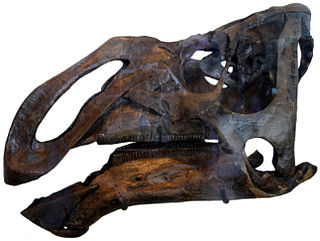
Kritosaurus is an incompletely known genus of hadrosaurid (duck-billed) dinosaur. It lived about 74.5-66 million years ago, in the Late Cretaceous of North America. The name means "separated lizard", but is often mistranslated as "noble lizard" in reference to the presumed "Roman nose".

Olorotitan was a monotypic genus of lambeosaurine duck-billed dinosaur, containing a single species, Olorotitan arharensis. It was among the last surviving non-avian dinosaurs to go extinct during the Cretaceous–Paleogene extinction event, having lived from the middle to late Maastrichtian-age of the Late Cretaceous era. The remains were found in the Udurchukan Formation beds of Kundur, Arkharinsky District, Amur Oblast, Eastern Russia, in the vicinity of the Amur River.

Lophorhothon is a genus of hadrosauroid dinosaur from the Late Cretaceous of Alabama and North Carolina. It was the first genus of dinosaur discovered in Alabama, in the United States.

Barsboldia is a genus of large hadrosaurid dinosaur from the early Maastrichtian Nemegt Formation of Ömnogöv', Mongolia. It is known from a partial vertebral column, partial pelvis, and some ribs.
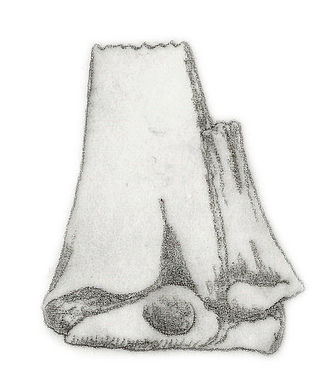
Ornithotarsus is a genus of hadrosaurid ornithopod dinosaurs that lived in North America during the Late Cretaceous Period in what is now the Merchantville Formation about 84 million to 78 million years ago.
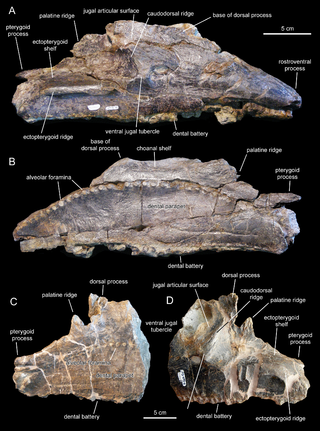
Pararhabdodon is a genus of tsintaosaurin hadrosaurid dinosaur, from the Maastrichtian-age Upper Cretaceous Tremp Group of Spain. The first remains were discovered from the Sant Romà d’Abella fossil locality and assigned to the genus Rhabdodon, and later named as the distinct species Pararhabdodon isonensis in 1993. Known material includes assorted postcranial remains, mostly vertebrae, as well as maxillae from the skull. Specimens from other sites, including remains from France, a maxilla previously considered the distinct taxon Koutalisaurus kohlerorum, an additional maxilla from another locality, the material assigned to the genera Blasisaurus and Arenysaurus, and the extensive Basturs Poble bonebed have been considered at different times to belong to the species, but all of these assignments have more recently been questioned. It was one of the last non-avian dinosaurs known from the fossil record that went extinct during the Cretaceous-Paleogene extinction event.
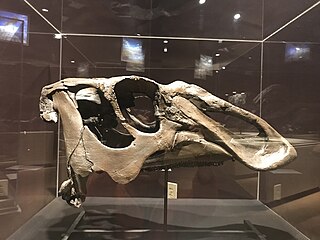
Naashoibitosaurus is a genus of hadrosaurid dinosaur that lived about 73 million years ago, in the Late Cretaceous, and was found in the Kirtland Formation of the San Juan Basin in New Mexico, United States. Only a partial skeleton has been found to date. It was first described as a specimen of Kritosaurus by Jack Horner, and has been intertwined with Kritosaurus since its description.

Saurolophinae is a subfamily of hadrosaurid dinosaurs. It has since the mid-20th century generally been called the Hadrosaurinae, a group of largely non-crested hadrosaurs related to the crested sub-family Lambeosaurinae. However, the name Hadrosaurinae is based on the genus Hadrosaurus which was found in more recent studies to be more primitive than either lambeosaurines or other traditional "hadrosaurines", like Edmontosaurus and Saurolophus. As a result of this, the name Hadrosaurinae was dropped or restricted to Hadrosaurus alone, and the subfamily comprising the traditional "hadrosaurines" was renamed the Saurolophinae. Recent phylogenetic work by Hai Xing indicates that Hadrosaurus is placed within the monophyletic group containing all non-lambeosaurine hadrosaurids. Under this view, the traditional Hadrosaurinae is resurrected, with the Hadrosauridae being divided into two clades: Hadrosaurinae and Lambeosaurinae.

The Hadrosaurus foulkii Leidy Site is a historic paleontological site in Haddonfield, Camden County, New Jersey. Now set in state-owned parkland, it is where the first relatively complete set of dinosaur bones were discovered in 1838, and then fully excavated by William Parker Foulke in 1858. The dinosaur was later named Hadrosaurus foulkii by Joseph Leidy. The site, designated a National Historic Landmark in 1994, is now a small park known as "Hadrosaurus Park" and is accessed at the eastern end of Maple Avenue in northern Haddonfield.

Latirhinus is an extinct genus of lambeosaurine hadrosaurid dinosaur from the Late Cretaceous of Mexico. The type species, Latirhinus uitstlani, was named in 2012 on the basis of a partial skeleton from the Campanian-age Cerro del Pueblo Formation. The specific name uitstlani means "southern" in the Náhuatl language of Mexico, a reference to the species' southern occurrence in the Cretaceous landmass Laramidia.
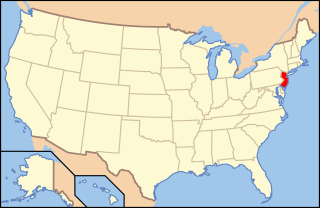
Paleontology in New Jersey refers to paleontological research in the U.S. state of New Jersey. The state is especially rich in marine deposits.

This timeline of hadrosaur research is a chronological listing of events in the history of paleontology focused on the hadrosauroids, a group of herbivorous ornithopod dinosaurs popularly known as the duck-billed dinosaurs. Scientific research on hadrosaurs began in the 1850s, when Joseph Leidy described the genera Thespesius and Trachodon based on scrappy fossils discovered in the western United States. Just two years later he published a description of the much better-preserved remains of an animal from New Jersey that he named Hadrosaurus.
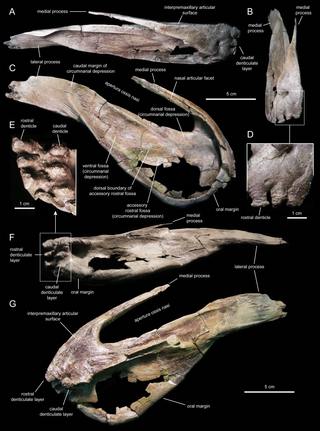
Eotrachodon orientalis is a species of hadrosaurid that was described in 2016. The holotype was found in the Mooreville Chalk Formation in Alabama in 2007 and includes a well-preserved skull and partial skeleton, making it a rare find among dinosaurs of Appalachia. Another primitive hadrosaur, Lophorhothon, is also known from the same formation, although Eotrachodon lived a few million years prior. A phylogenetic study has found Eotrachodon to be the sister taxon to the hadrosaurid subfamilies Lambeosaurinae and Saurolophinae. This, along with the other Appalachian hadrosaur Hadrosaurus and possibly Lophorhothon, Claosaurus and both species of Hypsibema, suggests that Appalachia was the ancestral area of Hadrosauridae.

Bonapartesaurus is an extinct genus of herbivorous ornithopod dinosaur belonging to Hadrosauridae, which lived in the area of modern Argentina during the Campanian and Maastrichtian stages of the Late Cretaceous.


































